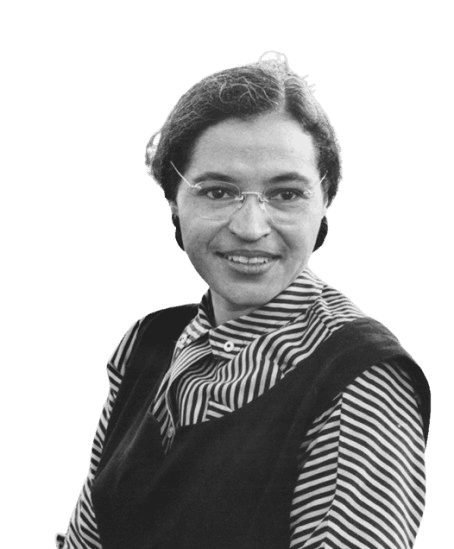Life and achievements
Early life
Rosa Louise McCauley was born in Tuskegee, Alabama, on February 4, 1913. She grew up in Pine Level, Alabama, after her parents got a divorce, and her mother took her to live with her grandparents. Rosa was born in the segregated South and thus had to endure the effects of racism from an early age. She went to the Industrial School for Girls in Montgomery, where she was taught how to sew and other domestic skills.
This is because Rosa had to drop out of school to care for her sick grandmother and, later, her mother. However, she kept her spirit of struggle and wanted to achieve her goals. Rosa married Raymond Parks, a barber and an NAACP member, in 1932. Thanks to Raymond, she was able to finish high school when very few black people had a chance to do so. Rosa's activism for the NAACP increased, and she became the secretary of the Montgomery branch in 1943.
While working as a seamstress, Rosa was also engaged in the struggle for black people's rights. She fought against cases of racial violence and tried to ensure African Americans' right to vote. She was passionate about civil rights, which is why she did all that was possible to improve the lives of African Americans in Montgomery.
Legacy
Rosa Parks symbolized courage and did not relinquish the fight for justice. Her refusal to give up her seat on a bus on December 1, 1955, was one of the most historical moments in the Civil Rights Movement. This act of defiance sparked the Montgomery Bus Boycott, a nonviolent protest lasting 381 days. It finally saw the desegregation of the buses in Montgomery. Parks' actions symbolized the struggle against segregation, and many others followed her example and stood up for their rights.
Following the boycott, Parks remained active in the civil rights struggle in Detroit, Michigan. She worked for Congressman John Conyers and joined many civil rights campaigns. She concentrated on matters of concern like housing, welfare, education, and job bias. Parks, however, was not spared from financial and health problems in her later years, but she never wavered in her commitment to the cause of justice.
Rosa Parks was recognized for her efforts and was awarded the Presidential Medal of Freedom and the Congressional Gold Medal. She even has a statue in the U.S. Capitol's National Statuary Hall. Her work is still relevant today, and people are still being encouraged to fight for their rights and against oppression. Rosa Parks's life and actions exemplify how one person can improve the world.
Join Confinity today to protect your digital privacy and take control of your online presence. Signup Now
Learn how historical figures leave behind lasting legacies that shape culture →
Milestone moments
Dec 1, 2024
Rosa Parks' Arrest
Rosa Parks was arrested on December 1 in the year 1955, for not obeying the order to relinquish her seat to a white passenger on a bus in Montgomery, Alabama.
This revolt led to the Montgomery Bus Boycott, a significant event in the Civil Rights Movement.
Parks' arrest also exposed the inequality of the black race and inspired the African American population to stand up for their rights against the discrimination they faced.
Dec 2, 1955
Montgomery Bus Boycott Begins
The Montgomery Bus Boycott is considered to have started on December 5, 1955, and lasted for 381 days.
The Montgomery Improvement Association coordinated the boycott with Rev. Martin Luther King Jr. as its head to fight against racial discrimination in buses.
The boycott led to a Supreme Court decision that segregation on the buses was unconstitutional, which was a significant achievement of the Civil Rights Movement.
Nov 13, 1956
The Supreme Court of the United States in the Bus Segregation Case
The United States Supreme Court, on November 13 1956, affirmed another court's ruling in Browder v. Gayle, stating that bus segregation was unlawful.
This decision ended the Montgomery Bus Boycott and ordered the integration of public transportation in Montgomery.
It was a historic decision in the fight for equality and paved the way for future desegregation cases.
Aug 22, 1957
Move to Detroit
1957, Rosa Parks and her husband relocated to Detroit, Michigan, where she resumed her civil rights fight.
Parks was an employee of Congressman John Conyers and engaged in many local and national campaigns against racial prejudice.
Her activism in Detroit focused mainly on housing, welfare, education, and job discrimination, and she was, therefore, part of the struggle for civil rights in the North.
